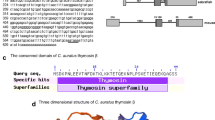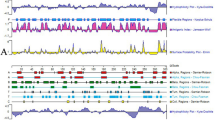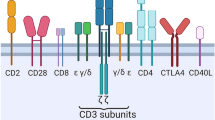Abstract
The CD3 coreceptor is a master T cell surface marker, and genes encoding CD3ζ, γδ, and ε chains have been reported in several teleost fish. Here, a complete cDNA sequence of CD3ɛ chain was identified from a sea bass (Dicentrarchus labrax L.) gill transcriptome. Its basal expression was quantified in both lymphoid and non-lymphoid organs of sea bass juveniles with real-time qPCR analysis. After either in vitro stimulation of head kidney leukocytes with the T-cell mitogen phytohaemagglutinin or in vivo stimulation with an orally administered Vibrio anguillarum vaccine, CD3ε expression levels increased in head kidney leukocytes, confirming that CD3ε T cells may play important roles in fish systemic protection against pathogens. Further, three peptides were designed on the CD3ɛ cytoplasmic tail region and employed as immunogens for antibody production in rabbit. One antiserum so obtained, named RACD3/1, immunostained a band of the expected size in a western blot of a sea bass thymocyte lysate. The distribution of CD3ε+ lymphocyte population in the lymphoid organs and mucosal tissues was addressed in healthy fish by IHC. In decreasing percentage order, CD3ε+ lymphocytes were detected by flow cytometry in thymus, peripheral blood leukocytes, gills, head kidney, gut, and spleen. Finally, a significant in vivo enhancement of CD3ε+ T intestinal lymphocytes was found in fish fed on diets in which 100% fish meal was replaced by the microalgae Nannochloropsis sp. biomass. These results indicate that CD3ε+ T cells are involved in nutritional immune responses.










Similar content being viewed by others
References
Abelli L, Picchietti S, Romano N, Mastrolia L, Scapigliati G (1997) Immunohistochemistry of gut-associated lymphoid tissue of the sea bass Dicentrarchus labrax (L.). Fish Shellfish Immunol 7:235–245. https://doi.org/10.1006/fsim.1996.0079
Amar EC, Kiron V, Satoh S, Watanabe T (2004) Enhancement of innate immunity in rainbow trout (Oncorhynchus mykiss Walbaum) associated with dietary intake of carotenoids from natural products. Fish Shellfish Immunol 16:527–537. https://doi.org/10.1016/j.fsi.2003.09.004
Araki K, Suetake H, Kikuchi K, Suzuki Y (2005) Characterization and expression analysis of CD3ɛ and CD3γ/δ in fugu, Takifugu rubripes. Immunogenetics 57:158–163. https://doi.org/10.1007/s00251-005-0772-8
Azeredo R, Pérez-Sánchez J, Sitjà-Bobadilla A, Fouz B, Tort L, Aragão C, Oliva-Teles A, Costas B (2015) European sea bass (Dicentrarchus labrax) immune status and disease resistance are impaired by arginine dietary supplementation. PLoS ONE 10:e0139967. https://doi.org/10.1371/journal.pone.0139967
Bakke-McKellep AM, Frøystad MK, Lilleeng E, Dapra F, Refstie S, Krogdahl Å, Landsverk T (2007) Response to soy: T-cell-like reactivity in the intestine of Atlantic salmon, Salmo salar L. J Fish Dis 30:13–25. https://doi.org/10.1111/j.1365-2761.2007.00769.x
Becker EW (2007) Micro-algae as a source of protein. Biotechnol Adv 25:207–210. https://doi.org/10.1016/j.biotechadv.2006.11.002
Bertram EM, Wilkinson RG, Lee BA, Jilbert AR, Kotlarski I (1996) Identification of duck T lymphocytes using an anti-human T cell (CD3) antiserum. Vet Immunol Immunopathol 51:353–363. https://doi.org/10.1016/0165-2427(95)05528-2
Birnbaum ME, Berry R, Hsiao Y-S, Chen Z, Shingu-Vazquez MA, Yu X, Waghray D, Fischer S, McCluskey J, Rossjohn J, Walz T, Garcia KC (2014) Molecular architecture of the αβ T cell receptor–CD3 complex. Proc Natl Acad Sci 111:17576–17581. https://doi.org/10.1073/pnas.1420936111
Boardman et al., 2012Boardman T, Warner C, Ramirez-Gomez F, Matrisciano J, Bromage E (2012) Characterization of an anti-rainbow trout (Oncorhynchus mykiss) CD3ɛ monoclonal antibody. Vet Immunol Immunopathol 145:511–515. https://doi.org/10.1016/j.vetimm.2011.11.017
Brodeur JF, Li S, Martins MDS, Larose L, Dave VP (2009) Critical and multiple roles for the cd3 intracytoplasmic tail in double negative to double positive thymocyte differentiation. J Immunol 182:4844–4853. https://doi.org/10.4049/jimmunol.0803679
Buonocore F, Castro R, Randelli E, Lefranc MP, Six A, Kuhl H, Reinhardt R, Facchiano A, Boudinot P, Scapigliati G (2012) Diversity, molecular characterization and expression of t cell receptor γ in a teleost fish, the sea bass (Dicentrarchus labrax, L). PLoS ONE 7:1–11. https://doi.org/10.1371/journal.pone.0047957
Buonocore F, Randelli E, Bird S, Secombes C, Costantini S, Facchiano A, Mazzini M, Scapigliati G (2006) The CD8α from sea bass (Dicentrarchus labrax L.): Cloning, expression and 3D modelling. Fish Shellfish Immunol 3:637–646. https://doi.org/10.1016/j.fsi.2005.08.006
Buonocore F, Randelli E, Bird S, Secombes CJ, Facchiano A, Costantini S, Scapigliati G (2007a) Interleukin-10 expression by real-time PCR and homology modelling. Aquaculture 270:512–522. https://doi.org/10.1016/j.aquaculture.2007.05.040
Buonocore F, Randelli E, Casani D, Costantini S, Facchiano A, Scapigliati G, Stet R (2007b) Molecular cloning, differential expression and 3D structural analysis of the MHC class-II β chain from sea bass (Dicentrarchus labrax L.). Fish Shellfish Immunol 23:853–866. https://doi.org/10.1016/j.fsi.2007.03.013
Buonocore F, Randelli E, Casani D, Guerra L, Picchietti S, Costantini S, Facchiano A, Zou J, Secombes C, Scapigliati G (2008) A CD4 homologue in sea bass (Dicentrarchus labrax): Molecular characterization and structural analysis. Mol Immunol 45:3168–3177. https://doi.org/10.1016/j.molimm.2008.02.024
Burnell G, Allan GL (2009) New technologies in aquaculture: Improving production efficiency, quality and environmental management. CRC Press. ISBN 9781845693848
Castro R, Bernard D, Lefranc MP, Six A, Benmansour A, Boudinot P (2011) T cell diversity and TcR repertoires in teleost fish. Fish Shellfish Immunol 31:644–654. https://doi.org/10.1016/j.fsi.2010.08.016
Cerezuela R, Guardiola F, Meseguer J, Esteban MÁ (2012) Enrichment of gilthead seabream (Sparus aurata L.) diet with microalgae: Effects on the immune system. Fish Physiol Biochem 38:1729–1739. https://doi.org/10.1007/s10695-012-9670-9
Cook MT, Morrison RN, Wilkinson R, Nowak BF, Hayball PJ, Hayball JD (2001) A screen of mammalian antibodies on snapper (Pagrus auratus, Sparidae) peripheral blood leukocytes reveals cross reactivity of an anti-human CD3 antibody with a population of mIg- cells. Dev Comp Immunol 25:553–559. https://doi.org/10.1016/S0145-305X(01)00024-6
Dave VP (2009) Hierarchical role of CD3 chains in thymocyte development. Immunol Rev 232:22–33. https://doi.org/10.1111/j.1600-065X.2009.00835.x
Davis MM, Chien YH (2003) T-cell antigen receptors. In: Paul W (ed) Fundamental Immunology, 5th edn. Lippincott Williams & Wilkins Publishers, Philadelphia, USA, pp 27–258
Dawood, 2020 MAO Dawood 2020 Nutritional immunity of fish intestines: Important insights for sustainable aquaculture Rev Aquac 1-22. https://doi.org/10.1111/raq.12492
Douek DC, Altmann DM (2000) T-cell apoptosis and differential human leucocyte antigen class II expression in human thymus. Immunology 99:249–256. https://doi.org/10.1046/j.1365-2567.2000.00940.x
Edgar RC (2004) MUSCLE: Multiple sequence alignment with high accuracy and high throughput. Nucleic Acids Res 32:1792–1797. https://doi.org/10.1093/nar/gkh340
Flajnik MF (2018) A cold-blooded view of adaptive immunity. Nat Rev Immunol 18:438–453. https://doi.org/10.1038/s41577-018-0003-9
Galindo-Villegas J, Mulero I, García-Alcazar A, Muñoz I, Peñalver-Mellado M, Streitenberger S, Scapigliati G, Meseguer J, Mulero V (2013) Recombinant TNFα as oral vaccine adjuvant protects European sea bass against vibriosis: Insights into the role of the CCL25/CCR9 axis. Fish Shellfish Immunol 35:1260–1271. https://doi.org/10.1016/j.fsi.2013.07.046
Ge Q, Zhao Y (2013) Evolution of thymus organogenesis. Dev Comp Immunol 39:85–90. https://doi.org/10.1016/j.dci.2012.01.002
Gouaillard C, Huchenq-Champagne A, Arnaud J, Chen CH, Rubin B (2001) Evolution of T cell receptor (TCR) α β heterodimer assembly with the CD3 complex. Eur J Immunol 31:3798–3805. https://doi.org/10.1002/1521-4141(200112)31:12%3c3798::AID-IMMU3798%3e3.0.CO;2-Z
Guo G, Nie P (2013) Sequencing and expression analysis of CD3γ/δ and CD3ɛ chains in mandarin fish, Siniperca chuatsi. Chinese J Oceanol Limnol 31:106–117. https://doi.org/10.1007/s00343-013-2018-1
Hayes SM, Shores EW, Love PE (2003) An architectural perspective on signaling by the pre-, alphabeta and gammadelta T cell receptors. Immunol Rev 191:28–37. https://doi.org/10.1034/j.1600-065x.2003.00011.x
Kaattari SL, Irwin MJ (1985) Salmonid spleen and anterior kidney harbor populations of lymphocytes with different B cell repertoires. Dev Comp Immunol 9:433–444. https://doi.org/10.1016/0145-305X(85)90006-0
Keresztes G, Glávits R, Krenács L, Kurucz É, Andó I (1996) An anti-CD3ε serum detects T lymphocytes in paraffin-embedded pathological tissues in many animal species. Immunol Lett 50:167–172. https://doi.org/10.1016/0165-2478(96)02534-5
Koppang EO, Fischer U, Moore L, Tranulis MA, Dijkstra JM, Köllner B, Aune L, Jirillo E, Hordvik I (2010) Salmonid T cells assemble in the thymus, spleen and in novel interbranchial lymphoid tissue. J Anat 217:728–739. https://doi.org/10.1111/j.1469-7580.2010.01305.x
Kuhl H, Tine M, Beck A, Timmermann B, Kodira C, Reinhardt R (2011) Directed sequencing and annotation of three Dicentrarchus labrax L. chromosomes by applying Sanger- and pyrosequencing technologies on pooled DNA of comparatively mapped BAC clones. Genomics. https://doi.org/10.1016/j.ygeno.2011.06.004
Kumar S, Stecher G, Tamura K (2016) MEGA7: Molecular Evolutionary Genetics Analysis Version 7.0 for Bigger Datasets. Mol Biol Evol 33:1870–1874. https://doi.org/10.1093/molbev/msw054
Laing KJ, Hansen JD (2011) Fish T cells: Recent advances through genomics. Dev Comp Immunol 35:1282–1295. https://doi.org/10.1016/j.dci.2011.03.004
Liu Y, Moore L, Koppang E, Hordvik I (2008) Characterization of the CD3ζ, CD3γδ and CD3ε subunits of the T cell receptor complex in Atlantic salmon. Dev Comp Immunol 32:26–35. https://doi.org/10.1016/j.dci.2007.03.015
Maisey K, Montero R, Corripio-Miyar Y, Toro-Ascuy D, Valenzuela B, Reyes-Cerpa S, Sandino AM, Zou J, Wang T, Secombes CJ, Imarai M (2016) Isolation and characterization of salmonid CD4+ T cells. J Immunol 196:4150–4163. https://doi.org/10.4049/jimmunol.1500439
Maisey et al., 2011Maisey K, Toro-Ascuy D, Montero R, Reyes-Lopez FE, Imarai M (2011) Identification of CD3 epsilon, CD4, CD8 beta splice variants of Atlantic salmon. Fish Shellfish Immunol 31:815–822. https://doi.org/10.1016/j.fsi.2011.07.022
Milićević NM, Nohroudi K, Milićević Ž, Hedrich HJ, Westermann J (2005) T cells are required for the peripheral phase of B-cell maturation. Immunology 116:308–317. https://doi.org/10.1111/j.1365-2567.2005.02226.x
Miller JB, Hsu R, Heinrikson R, Yachnin S (1975) Extensive homology between the subunits of the phytohemagglutinin mitogenic proteins derived from Phaseolus vulgaris. Proc Natl Acad Sci 72:1388–1391. https://doi.org/10.1073/pnas.72.4.1388
Miyara M, Sakaguchi S (2007) Natural regulatory T cells: Mechanisms of suppression. Trends Mol Med 13:108–116. https://doi.org/10.1016/j.molmed.2007.01.003
Miyazawa R, Murata N, Matsuura Y, Shibasaki Y, Yabu T, Nakanishi T (2018) Peculiar expression of CD3-epsilon in kidney of ginbuna crucian carp. Front Immunol 9:1321. https://doi.org/10.3389/fimmu.2018.01321
Nakagawa H, Montgomery WL (2007) Algae. In: Nakagawa H, Sato M, Gatlin DM (eds) Dietary supplements for the health and quality of cultured fish. CAB International. ISBN 1845931998
Nakanishi T, Shibasaki Y, Matsuura Y (2015) T Cells in Fish Biology (Basel) 4:640–663. https://doi.org/10.3390/biology4040640
Nayak S, Al Ashhab A, Zilberg D, Khozin-Goldberg I (2020) Dietary supplementation with omega-6 LC-PUFA-rich microalgae regulates mucosal immune response and promotes microbial diversity in the zebrafish gut. Biology (Basel) 9:119. https://doi.org/10.3390/biology9060119
Nuñez-Ortiz N, Pascoli F, Picchietti S, Buonocore F, Bernini C, Toson M, Scapigliati G, Toffan A (2016) A formalin-inactivated immunogen against viral encephalopathy and retinopathy (VER) disease in European sea bass (Dicentrarchus labrax): Immunological and protection effects. Vet Res 47:89–99. https://doi.org/10.1186/s13567-016-0376-3
Nuñez Ortiz N, Gerdol M, Stocchi V, Marozzi C, Randelli E, Bernini C, Buonocore F, Picchietti S, Papeschi C, Sood N, Pallavicini A, Scapigliati G (2014) T cell transcripts and T cell activities in the gills of the teleost fish sea bass (Dicentrarchus labrax). Dev Comp Immunol 47:309–318. https://doi.org/10.1016/j.dci.2014.07.015
Øvergård A, Hordvik I, Nerland A, Eikeland G, Patel S (2009) Cloning and expression analysis of Atlantic halibut (Hippoglossus hippoglossus) CD3 genes. Fish Shellfish Immunol 27:707–713. https://doi.org/10.1016/j.fsi.2009.08.011
Park C-I, Hirono I, Enomoto J, Nam B-H, Aoki T (2001) Cloning of Japanese flounder Paralichthys olivaceus CD3 cDNA and gene, and analysis of its expression. Immunogenetics 53:130–135. https://doi.org/10.1007/s002510100311
Park C-I, Hirono I, Aoki T (2005) Molecular characterization of the Japanese flounder, Paralichthys olivaceus, CD3epsilon and evolution of the CD3 cluster. Dev Comp Immunol 29(2):123–133. https://doi.org/10.1016/j.dci.2004.06.004
Parra Z, Lillie M, Miller R (2012) A model for the evolution of the mammalian t-cell receptor α/δ and μ loci based on evidence from the duckbill platypus. Mol Biol Evol 29:3205–3214. https://doi.org/10.1093/molbev/mss128
Pearse G (2006) Normal structure, function and histology of the thymus. Toxicol Pathol 34:504–514. https://doi.org/10.1080/01926230600939856
Pettinello R, Redmond AK, Secombes CJ, Macqueen DJ, Dooley H (2017) Evolutionary history of the T cell receptor complex as revealed by small-spotted catshark (Scyliorhinus canicula). Dev Comp Immunol 74:125–135. https://doi.org/10.1016/j.dci.2017.04.015
Picchietti S, Abelli L, Guerra L, Randelli E, Proietti Serafini F, Belardinelli MC, Buonocore F, Bernini C, Fausto AM, Scapigliati G (2015) MHC II-β chain gene expression studies define the regional organization of the thymus in the developing bony fish Dicentrarchus labrax (L.). Fish Shellfish Immunol 42:483–493. https://doi.org/10.1016/j.fsi.2014.11.012
Picchietti S, Guerra L, Bertoni F, Randelli E, Belardinelli MC, Buonocore F, Fausto AM, Rombout JH, Scapigliati G, Abelli L (2011) Intestinal T cells of Dicentrarchus labrax (L.): Gene expression and functional studies. Fish Shellfish Immunol 30:609–617. https://doi.org/10.1016/j.fsi.2010.12.006
Picchietti S, Guerra L, Buonocore F, Randelli E, Fausto AM, Abelli L (2009) Lymphocyte differentiation in sea bass thymus: CD4 and CD8-α gene expression studies. Fish Shellfish Immunol 27:50–56. https://doi.org/10.1016/j.fsi.2009.04.003
Picchietti S, Guerra L, Selleri L, Buonocore F, Abelli L, Scapigliati G, Mazzini M, Fausto AM (2008) Compartmentalisation of T cells expressing CD8α and TCRβ in developing thymus of sea bass Dicentrarchus labrax (L.). Dev Comp Immunol 32:92–99. https://doi.org/10.1016/j.dci.2007.04.002
Picchietti S, Nuñez-Ortiz N, Stocchi V, Randelli E, Buonocore F, Guerra L, Scapigliati G (2017) Evolution of lymphocytes immunoglobulin T of the sea bass (Dicentrarchus labrax): quantitation of gene expressing and immunoreactive cells. Fish Shellfish Immunol 63:40–52. https://doi.org/10.1016/j.fsi.2017.02.002
Pinto R, Randelli E, Buonocore F, Pereira P, dos Santos N (2013) Molecular cloning and characterization of sea bass (Dicentrarchus labrax, L.) MHC class I heavy chain and β2-microglobulin. Dev Comp Immunol 39:234–254. https://doi.org/10.1016/j.dci.2012.10.002
Randellin E, Scapigliati G, Buonocore F (2011) CD3γ/δ in sea bass (Dicentrarchus labrax): Molecular characterization and expression analysis. Results Immunol 1:31–35. https://doi.org/10.1016/j.rinim.2011.08.003
Reese MG, Eeckman FH, Kulp D, Haussler D (1997) Improved splice site detection in Genie. J Comput Biol 4:311–323. https://doi.org/10.1089/cmb.1997.4.311
Rombout JHWM, Huttenhuis HBT, Picchietti S, Scapigliati G (2005) Phylogeny and ontogeny of fish leucocytes. Fish Shellfish Immunol 19:441–455. https://doi.org/10.1016/j.fsi.2005.03.007
Ronza P, Bermudez R, Losada AP, Robles A, Quiroga MI (2011) Mucosal CD3ε+ cell proliferation and gut epithelial apoptosis: Implications in rainbow trout gastroenteritis (RTGE). J Fish Dis 34:433–443. https://doi.org/10.1111/j.1365-2761.2011.01254.x
Scapigliati G, Mazzini M, Mastrolia L, Romano N, Abelli L (1995) Production and characterisation of a monoclonal antibody against the thymocytes of the sea bass Dicentrarchus labrax (L.) (Teleostea, Percicthydae). Fish Shellfish Immunol 5:393–405. https://doi.org/10.1006/fsim.1995.0039
Scapigliati G, Meloni S, Buonocore F, Bossù P, Prugnoli D, Secombes CJ (2003) Immunopurification of B lymphocytes from sea bass Dicentrarchus labrax (L.). Mar Biotechnol 5:214–221. https://doi.org/10.1007/s10126-002-0100-3
Scapigliati G, Romano N, Picchietti S, Mazzini M, Mastrolia L, Scalia D, Abelli L (1996) Monoclonal antibodies against sea bass Dicentrarchus labrax (L.) immunoglobulins: Immunolocalisation of immunoglobulin-bearing cells and applicability in immunoassays. Fish Shellfish Immunol 6:383–401. https://doi.org/10.1006/fsim.1996.0038
Shang N, Sun X, Hu W, Wang Y, Guo Q (2008) Molecular cloning and characterization of common carp (Cyprinus carpio L.) TCRγ and CD3γ/δ chains. Fish Shellfish Immunol 24:412–425. https://doi.org/10.1016/j.fsi.2007.12.007
Stocchi V, Wang T, Randelli E, Mazzini M, Gerdol M, Pallavicini A, Secombes CJ, Scapigliati G, Buonocore F (2017) Evolution of Th2 responses: Characterization of IL-4/13 in sea bass (Dicentrarchus labrax L.) and studies of expression and biological activity. Sci Rep 7:1–15. https://doi.org/10.1038/s41598-017-02472-y
Toda H, Saito Y, Koike T, Takizawa F, Araki K, Yabu T, Somamoto T, Suetake H, Suzuki Y, Ototake M, Moritomo T, Nakanishi T (2011) Conservation of characteristics and functions of CD4 positive lymphocytes in a teleost fish. Dev Comp Immunol 35:650–660. https://doi.org/10.1016/j.dci.2011.01.013
Toda H, Shibasaki Y, Koike T, Ohtani M, Takizawa F, Ototake M, Moritomo T, Nakanishi T (2009) Alloantigen-specific killing is mediated by CD8-positive T cells in fish. Dev Comp Immunol 33:646–652. https://doi.org/10.1016/j.dci.2008.11.008
Vo Van B, Siddik MAB, Fotedar R, Chaklader MR, Hanif MA, Foysal MJ, Nguyen HQ (2020) Progressive replacement of fishmeal by raw and enzyme-treated alga, Spirulina platensis influences growth, intestinal micromorphology and stress response in juvenile barramundi Lates calcarifer Aquaculture 529. https://doi.org/10.1016/j.aquaculture.2020.735741
Vogel C, Marcotte EM (2012) Insights into the regulation of protein abundance from proteomic and transcriptomic analyses. Nat Rev Genet. https://doi.org/10.1038/nrg3185
Xing J, Ma J, Tang X, Sheng X, Zhan W (2017) Characterizations of CD4-1, CD4-2 and CD8β T cell subpopulations in peripheral blood leucocytes, spleen and head kidney of Japanese flounder (Paralichthys olivaceus). Mol Immunol 85:155–165. https://doi.org/10.1016/j.molimm.2017.02.015
Xing J, Zhang Z, Luo K, Tang X, Sheng X, Zhan W (2020) T and B lymphocytes immune responses in flounder (Paralichthys olivaceus) induced by two forms of outer membrane protein K from Vibrio anguillarum: Subunit vaccine and DNA vaccine. Mol Immunol. https://doi.org/10.1016/j.molimm.2019.12.002
Yang H, Oura CAL, Kirkham PA, Parkhouse RME (1996) Preparation of monoclonal anti-porcine CD3 antibodies and preliminary characterization of porcine T lymphocytes. Immunology 88:577–585. https://doi.org/10.1046/j.1365-2567.1996.d01-682.x
Yates AJ (2014) Theories and quantification of thymic selection. Front Immunol 5(13). https://doi.org/10.3389/fimmu.2014.00013
Zwollo P, Cole S, Bromage E, Kaattari S (2005) B Cell Heterogeneity in the teleost kidney: Evidence for a maturation gradient from anterior to posterior kidney. J Immunol 174:6608–6616. https://doi.org/10.4049/jimmunol.174.11.6608
Funding
This research was partially funded by the project ALGAFISH (PTDC/MAR-BIO/6233/2014-POCI-01-0145-FEDER016796), supported by FCT and co-financed by FEDER from COMPETE 2020 UID/Multi/04423/2019, and by the “Department of Excellence-2018” Program (Dipartimenti di Eccellenza) of the Italian Ministry of Education, University and Research, DIBAF-Department of University of Tuscia, Project “Landscape 4.0 – food, wellbeing and environment”.
Author information
Authors and Affiliations
Corresponding author
Ethics declarations
Conflict of interest
The authors declare that they have no conflict of interest.
Ethical approval
Animal manipulation during the diet experiments complied with the guidelines of the European Union Directive (2010/63/EU) and Portuguese legislation (DL113/2013) for animal treatments. The Organism for Animal Welfare of CIIMAR and the Portuguese Directorate-General for Food and Veterinary approved all the protocols performed in the present study (approval 0421/000/000/2017 DGAV). Fish handling was performed under ethylene glycol monophenyl ether anesthesia (0.3 mL/L; ref.: 8.07291.2500, Merck, Whitehouse Station, USA), and discomfort, stress, and pain to the experimental animals was avoided, as much as possible, along the experiment. For sampling, fish were euthanized by anesthetic overdose (ethylene glycol monophenyl ether; ref.: 8.07291.2500, Merck, Whitehouse Station, USA).
For the experiments performed in Italy, ethical approval by ethics committee was not required, as per the Explanatory note of the Italian Ministry of Health’s Directorate-General for Animal Health and Veterinary Medicinal Products (DGSAF) of 26 July 2017. Organs and tissues were dissected out following temporary immobilization with 1 mg/ml tricaine methane sulfonate (MS-222) (Sigma) in aquarium water, buffered with 0.6 g/L sodium bicarbonate. Anesthesia was followed by exsanguination or decapitation. All efforts were made to minimize suffering. The study was carried out in strict accordance to Directive 2010/63/EU of the European Parliament and of the Council of 22 September 2010 on the protection of animals used for scientific purposes and on National Legislative Decree 26 of 4 March 2014 “Attuazione della Direttiva 2010/63/UE sulla protezione degli animali utilizzati a fini scientifici.”
Additional information
Publisher’s Note
Springer Nature remains neutral with regard to jurisdictional claims in published maps and institutional affiliations.
Rights and permissions
About this article
Cite this article
Picchietti, S., Buonocore, F., Guerra, L. et al. Molecular and cellular characterization of European sea bass CD3ε+ T lymphocytes and their modulation by microalgal feed supplementation. Cell Tissue Res 384, 149–165 (2021). https://doi.org/10.1007/s00441-020-03347-x
Received:
Accepted:
Published:
Issue Date:
DOI: https://doi.org/10.1007/s00441-020-03347-x




